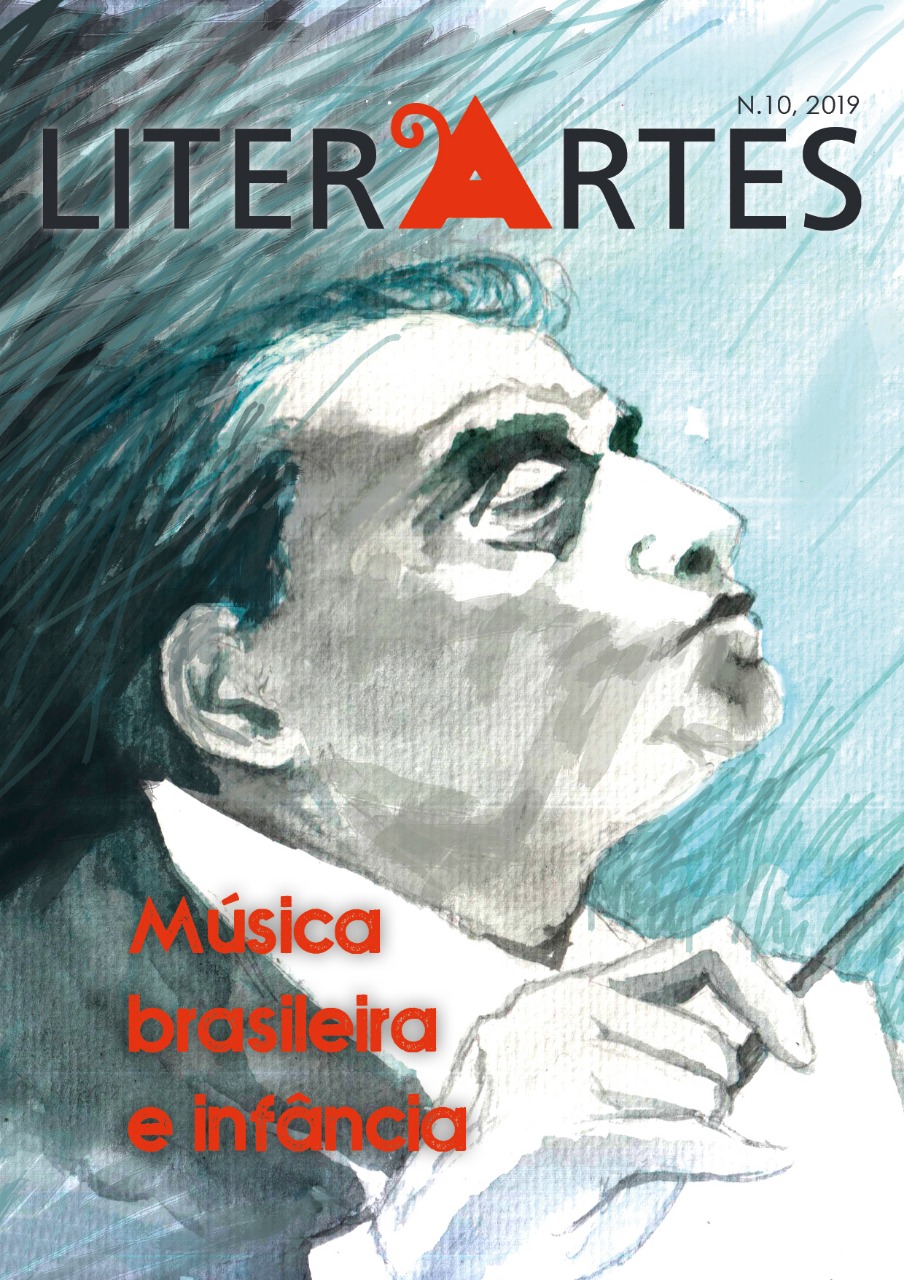The Villa-Lobos’ Cirandas for piano
from the children’s cultural universe to important works of the piano repertoire
DOI:
https://doi.org/10.11606/issn.2316-9826.literartes.2019.156852Keywords:
Villa-Lobos, Cirandas for piano, B. Asafiev, Theory of IntonationAbstract
This work investigates the Villa-Lobos’ treatment to the melodies used in Cirandas Terezinha de Jesus, Xô xô passarinho and Fui no Tororó, through intonational analyzes of the homonymous melodies arranged in the Guia Prático and also by the analyzes of the Cirandas themselves. These analyzes are based on the concepts of Russian musicologist B. Asafiev and allowed to understand the cultural and historical universe related to these three pieces, which are part of the 16 Cirandas, important work for piano of the twentieth century.
References
ABREU, M.; GUEDES, Z. R. O piano na música brasileira. Porto Alegre: Movimento, 1992.
ANDRADE, M. Música, doce Música. São Paulo: Martins Fontes; Brasília: Instituto Nacional do Livro, 1976.
ASAFIEV, B. V. Musykalnaia Forma kak Protsess. Leningrad: Musika, 1971.
Beethoven, L. v. Concerto para piano e orquestra nº 3 em Dó menor opus 37. Leipzig: Peters. edition. Partitura Disponível em
http://conquest.imslp.info/files/imglnks/usimg/d/de/IMSLP273097-SIBLEY1802.26609.e481-39087032502298score.pdf . Acessado em 10/04/2019
BENT, I. POPLE, A. Analysis . In: SADIE, Stanley (Ed.). The New Grove dictionary of music and musicians. v. 1. London: Macmillan, 2001. p. 526-589. Disponível em:
<http://www.oxfordmusiconline.com/subscriber/article/grove/music/41862pg1?q=ana
lysis&search=quick&pos=4&_start=1#firsthit>. Acesso em 19 dez. 2011.
CHERNAVSKY, A. Um maestro no gabinete; música e política no tempo de H. Villa-Lobos. Dissertação de Mestrado. Universidade Estadual de Campinas, 2003.
CHIANTORE, L. História de La Técnica Pianística. Madrid: Alianza Editorial, 2004.
DAHLET, V. A entonação no dialogismo bakhtiano (p. 263-279). In: Bakhtin, dialogismo e construção do sentido. BRAIT B. (org.). Campinas: Editora da Unicamp, 1997.
KHOLOPOVA, V. The Intonational Nature of Music. Artigo em Muzyka kak vid iskusstva, São Petersburgo, 2000. Disponível em: <http://www.kholopova.ru/bibeng1.html>. Acesso em: 17 jul. 2011.
LAGO, M. A. C., BARBOSA, S. Introdução. In: VILLA-LOBOS, H. Guia prático. 1° Volume, Separata. Rio de Janeiro: Funarte, Academia de Braseira de Música, 2009. p.17-44
________________________. Notas Editoriais. In: VILLA-LOBOS, H. Guia prático. 1° Volume, 2º Caderno. Rio de Janeiro: Funarte, Academia de Braseira de Música, 2009. p. 115-130
MELO, V. Folclore Infantil. Rio de Janeiro: Livraria Editora Cátedra. Brasília: INL, 1981.
SALLES, P. T. Villa-Lobos: Processos Composicionais. Campinas: Editora da Unicamp, 2009.
TARASTI, E. A Theory of Musical Semiotcs. Bloomington and Indianapolis: Indiana University Press, 1994.
VETROMILLA. M. H. M. C. Ciranda n° 7 de Villa-Lobos: Estudo da relação do texto musical e o enredo implícito da cantiga folclórica utilizada. Dissertação de Mestrado, UNIRIO. Rio de Janeiro: 2010.
VILLA-LOBOS, H. Cirandas. Rio de Janeiro: Arthur Napoleão, 1968. Partitura. Cópia Digital, disponível em http://imslp.org/wiki/As Cirandas,_W220_(Villa-Lobos,_Heitor).
________________. Guia prático. 1° Volume, 1° Caderno. Rio de Janeiro: Funarte, Academia de Brasileira de Música, 2009.
_______________. Guia prático. 1° Volume, 2° Caderno. Rio de Janeiro: Funarte, Academia de Brasileira de Música, 2009.
ANDRADE, M. Música, doce Música. São Paulo: Martins Fontes; Brasília: Instituto Nacional do Livro, 1976.
ASAFIEV, B. V. Musykalnaia Forma kak Protsess. Leningrad: Musika, 1971.
Beethoven, L. v. Concerto para piano e orquestra nº 3 em Dó menor opus 37. Leipzig: Peters. edition. Partitura Disponível em
http://conquest.imslp.info/files/imglnks/usimg/d/de/IMSLP273097-SIBLEY1802.26609.e481-39087032502298score.pdf . Acessado em 10/04/2019
BENT, I. POPLE, A. Analysis . In: SADIE, Stanley (Ed.). The New Grove dictionary of music and musicians. v. 1. London: Macmillan, 2001. p. 526-589. Disponível em:
<http://www.oxfordmusiconline.com/subscriber/article/grove/music/41862pg1?q=ana
lysis&search=quick&pos=4&_start=1#firsthit>. Acesso em 19 dez. 2011.
CHERNAVSKY, A. Um maestro no gabinete; música e política no tempo de H. Villa-Lobos. Dissertação de Mestrado. Universidade Estadual de Campinas, 2003.
CHIANTORE, L. História de La Técnica Pianística. Madrid: Alianza Editorial, 2004.
DAHLET, V. A entonação no dialogismo bakhtiano (p. 263-279). In: Bakhtin, dialogismo e construção do sentido. BRAIT B. (org.). Campinas: Editora da Unicamp, 1997.
KHOLOPOVA, V. The Intonational Nature of Music. Artigo em Muzyka kak vid iskusstva, São Petersburgo, 2000. Disponível em: <http://www.kholopova.ru/bibeng1.html>. Acesso em: 17 jul. 2011.
LAGO, M. A. C., BARBOSA, S. Introdução. In: VILLA-LOBOS, H. Guia prático. 1° Volume, Separata. Rio de Janeiro: Funarte, Academia de Braseira de Música, 2009. p.17-44
________________________. Notas Editoriais. In: VILLA-LOBOS, H. Guia prático. 1° Volume, 2º Caderno. Rio de Janeiro: Funarte, Academia de Braseira de Música, 2009. p. 115-130
MELO, V. Folclore Infantil. Rio de Janeiro: Livraria Editora Cátedra. Brasília: INL, 1981.
SALLES, P. T. Villa-Lobos: Processos Composicionais. Campinas: Editora da Unicamp, 2009.
TARASTI, E. A Theory of Musical Semiotcs. Bloomington and Indianapolis: Indiana University Press, 1994.
VETROMILLA. M. H. M. C. Ciranda n° 7 de Villa-Lobos: Estudo da relação do texto musical e o enredo implícito da cantiga folclórica utilizada. Dissertação de Mestrado, UNIRIO. Rio de Janeiro: 2010.
VILLA-LOBOS, H. Cirandas. Rio de Janeiro: Arthur Napoleão, 1968. Partitura. Cópia Digital, disponível em http://imslp.org/wiki/As Cirandas,_W220_(Villa-Lobos,_Heitor).
________________. Guia prático. 1° Volume, 1° Caderno. Rio de Janeiro: Funarte, Academia de Brasileira de Música, 2009.
_______________. Guia prático. 1° Volume, 2° Caderno. Rio de Janeiro: Funarte, Academia de Brasileira de Música, 2009.
Downloads
Published
2019-11-01
Issue
Section
Artigos
License
Autores que publicam nesta revista concordam com os seguintes termos:
- Autores mantém os direitos autorais e concedem à revista o direito de primeira publicação, com o trabalho simultaneamente licenciado sob a Licença Creative Commons Attribution que permite o compartilhamento do trabalho com reconhecimento da autoria e publicação inicial nesta revista.
- Autores têm autorização para assumir contratos adicionais separadamente, para distribuição não-exclusiva da versão do trabalho publicada nesta revista (ex.: publicar em repositório institucional ou como capítulo de livro), com reconhecimento de autoria e publicação inicial nesta revista.
- Autores têm permissão e são estimulados a publicar e distribuir seu trabalho online (ex.: em repositórios institucionais ou na sua página pessoal) a qualquer ponto antes ou durante o processo editorial, já que isso pode gerar alterações produtivas, bem como aumentar o impacto e a citação do trabalho publicado (Veja O Efeito do Acesso Livre).
How to Cite
TARQUINIO, Daniel Junqueira. The Villa-Lobos’ Cirandas for piano: from the children’s cultural universe to important works of the piano repertoire. Literartes, São Paulo, Brasil, v. 1, n. 10, p. 58–85, 2019. DOI: 10.11606/issn.2316-9826.literartes.2019.156852. Disponível em: https://journals.usp.br/literartes/article/view/156852.. Acesso em: 22 jul. 2024.



